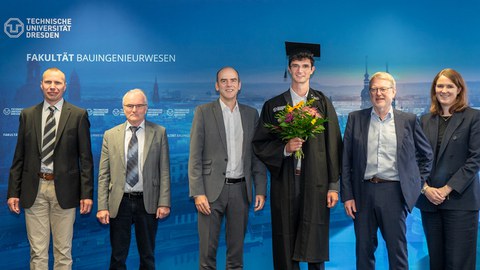Oct 07, 2024
Promotion Vivian Frei

Vivian Frei, M.Sc. and the doctoral committee present
On 30.09.2024, Mr. Vivian Frei, M.Sc. successfully defended his scientific thesis as part of the doctoral procedure with the topic "Analysis of the fatigue process of high-strength concrete considering the sample size". In addition to the chairman of the doctoral committee, Prof. Dr. Michael Kaliske (TU Dresden), Prof. Dr. Steffen Marx (TU Dresden), Prof. Dr. Frohmut Wellner (TU Dresden), Dr. Marc Thiele (Federal Institute for Materials Research and Testing) were present as reviewers. Prof. Dr. Katharina Kleinschrot (TU Dresden) was also present as a member of the doctoral committee.
Abstract:
For fatigue design, the transferability of laboratory results to structural dimensions presents a major challenge. The issue of transferability arises with regard to the size effect, considering the ever-increasing scale of structures such as wind turbines or bridges, as well as the properties of high-strength concrete mixtures. These are of particular interest for fatigue, because as concrete compressive strength increases, the ratio of cyclic to static loads also increases. The damage development depend on these and other influencing factors, which can be characterized through a damage analysis that accopmanies the entire service life. A reliable damage analysis also enables the assessment of the current condition of aged structures. A sound evaluation of damage development is based on a comprehensive understanding of the fatigue process.
Consequently, the aim of this work is to analyse the fatigue process under compressive
cyclic loading at three compressive strengths and three specimen sizes using mechanical
and acoustic testing methods. The hypothesis is that with increasing compressive strength
and specimen size, the occuring specimen changes decrease, or the brittleness increases.
This is based on a fracture mechanics size effect model, according to which the volume
fraction of a locally confined, anisotropic fracture damage zone in the specimen volume
decreases with increasing specimen size and homogeneity of the microstructure.
The occurence of a fracture damage zone in the third fatigue phase can be demonstrated
in high-strength concrete using both acoustic emission source localisation or ultrasonic
testing. The latter is used to analyse the anisotropic development of the ultrasonic pulse
velocity. Additionally, the preferential crack growth parallel to the load direction under
high stress levels is associated with an increase in plastic energy density.
With increasing compressive strength, a decrease in changes to the plastic specimen properties, such as compaction and axial strain, is observed. The ultrasonic velocity and
stiffness show smaller changes in high-strength concrete compared to normal-strength
concrete. The influence of the composition is discussd using the tested normal and high
strength concretes. With increasing specimen size, a decrease of the change of some specimen properties is determined for the composition HFB-2, while no size dependency is noted in composition HFB-1.
The fracture mechanics model can largely explain the observed dependence of the fatigue
process at the specimen scale on specimen size and compressive strength. Due to the
relation of load-parallel cracks with transverse strain and the dynamic modulus of elasticity derived from the ultrasonic pulse velocity perpendicular to the load direction, these specimen properties are discussed as damage indicators.
We would like to congratulate Mr. Vivian Frei on completing his doctorate and wish him all the best and every success for the future.
